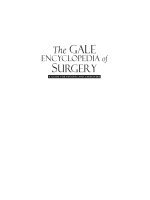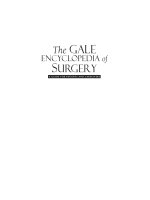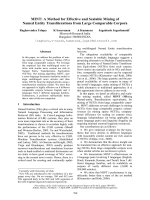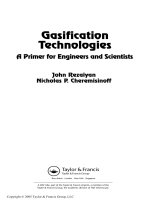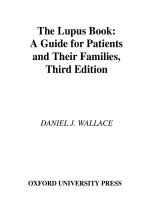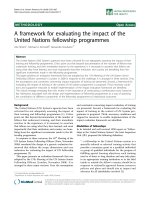WOCAT a framworks for documentation and valuation of soil and water conservation
Bạn đang xem bản rút gọn của tài liệu. Xem và tải ngay bản đầy đủ của tài liệu tại đây (7.08 MB, 131 trang )
WORLD OVERVIEW OF CONSERVATION APPROACHES AND TECHNOLOGIES
A Framework for
Documentation and Evaluation of
Soil and Water Conservation
TECHNOLOGIES
WOCAT Questionnaire
Revised February 2003
WOCAT
A Framework for
Documentation and Evaluation of
Soil and Water Conservation
Basic Source:
Coordination
& Editing:
A first edition of this document was finalised in an international workshop in Bern in December 1994,
based on a proposal by a task force meeting in Wageningen, and on tests in different parts of Africa. After
four regional workshops in Africa and a national workshop in Thailand, a revised version was discussed
during the International Workshops in Sigriswil and Murten, Switzerland in May 1996 and August 1997.
Additional workshops in Latin America and China in 1997 provided further opportunities to test and
improve the questionnaires. Major contributors were Dennis Cahill, Will Critchley, Rod Gallacher, Karl
Herweg, Hans Hurni, Hanspeter Liniger, Godert van Lynden, Kithinji Mutunga, Samran Sombatpanit,
Chen Shaodong, Kebede Tato and Donald Thomas. Additional assistance was provided by: Ali Ayoub,
Nie Bijuan, Malcolm Douglas, Gunter English, Louisa Jansen, Joseph Mburu, Amor Mtimet, Issa
Ousseini, David Sanders, Sutadi Sastrowihardjo, Dietmar Schorlemer, Anneke Trux, Anton Vlaanderen,
Gilbert Zomahoun, Michael Zoebisch and all SWC specialists from Africa, Asia, and Latin America who
participated in WOCAT workshops.
This revised version was edited by Hanspeter Liniger, Gudrun Schwilch, Godert van Lynden, Samran
Sombatpanit, Will Critchley and Mats Gurtner.
Hanspeter Liniger
Cartoons & Figures: Karl Herweg, Mats Gurtner
Proof-reading:
Ted Wachs, Marlène Thibault
Layout:
Mats Gurtner
Copyright 2003
WOCAT
Coordination:
WOCAT Management Group:
CDE - Centre for Development and Environment, Bern, Switzerland;
FAO - Food and Agriculture Organization of the United Nations, Rome, Italy;
ISRIC - International Soil Reference and Information Centre, Wageningen, Netherlands;
BSWM - Bureau of Soils and Water Management, Department of Agriculture, Quezon City, Philippines;
INSAH - Institut de Sahel, Bamako, Mali;
RELMA - Regional Land Management Unit (former RSCU), SIDA, Nairobi, Kenya;
SWCMC - Soil and Water Conservation Monitoring Center, MWR, Beijing, P.R. China
Contact address:
WOCAT, CDE, Steigerhubelstrasse 3, 3008 Bern, Switzerland,
Tel +41 31 631 88 22, Fax +41 31 631 85 44, e-mail:
BSWM
INSAH
SWCMC
A Framework for
Documentation and Evaluation of
Soil and Water Conservation
TECHNOLOGIES
WOCAT Questionnaire
Revised February 2003
Technology Code
QT
country
code
consecutive
number
WOCAT
i
Technologies
List of Collaborating and Funding Institutions1
ACT
ADB
ASOCON
BSWM
CAMP
CDCS
CDE
DANIDA
DEC
DED
FAO
“Friends of
WOCAT”
FSSRI / UPLB
African Conservation Tillage Network, Harare, Zimbabwe
Asian Development Bank, Manila, Philippines
Asia Soil Conservation Network, Jakarta, Indonesia
Bureau of Soils and Water Management, Department of Agriculture, Quezon City, Philippines
Central Asia Mountain Programme, Bishkek, Kyrgyzstan
International Cooperation Centre, Vrije Universiteit Amsterdam, The Netherlands
Centre for Development and Environment, University of Bern, Switzerland
Danish International Development Assistance, Copenhagen, Denmark
Department for Erosion Control, Faculty of Forestry, Belgrade University, Yugoslavia
Deutscher Entwicklungsdienst, Berlin, Germany
Food and Agriculture Organisation of the United Nations, Rome, Italy
Individuals without institutional backing
Farming Systems and Soil Resources Institute, University of the Philippines, Los Baños,
Philippines
Fujian Soil and Water Conservation Office, Fuzhou, China
FSWCO
Deutsche Gesellschaft für Technische Zusammenarbeit, Eschborn, Germany
GTZ
International Atomic Energy Agency, Joint FAO / IAEA Division, Vienna, Austria
IAEA
International Fund for Agricultural Development - Global Mechanism, Rome, Italy
IFAD-GM
International Centre for Agricultural Research in the Dry Areas, Aleppo, Syria
ICARDA
International Centre for Integrated Mountain Development, Kathmandu, Nepal
ICIMOD
International Crops Research Institute for the Semi-Arid Tropics, Niamey, Niger
ICRISAT
Institut du Sahel, Bamako, Mali
INSAH
ISCW / ARC Institute for Soil, Climate and Water of the Agricultural Research Council, Pretoria, South Africa
International Soil Reference and Information Centre, Wageningen, The Netherlands
ISRIC
International Water Management Institute, Pretoria, South Africa
IWMI
Kyrgyz Agrarian University, Bishkek, Kyrgyzstan
KAU
The Royal Veterinary and Agricultural University, Denmark
KVL
Land Development Department, Ministry of Agriculture and Cooperatives, Bangkok, Thailand
LDD
Ministry of Agriculture and Food Security, Soil Conservation and Land Use Planning Unit, Dar es
MAFSSalaam, Tanzania
SCLUPU
MoA, Ethiopia Ministry of Agriculture, Addis Abeba, Ethiopia
National Department of Agriculture, Pretoria, South Africa
NDA
Observatoire du Sahara et du Sahel, Tunis, Tunisia
OSS
Programa de Agricultura Sostenible en Laderas de América Central, Managua, Nicaragua
PASOLAC
Regional Land Management Unit (former RSCU), Sida, Nairobi, Kenya
RELMA
Swiss Agency for Development and Cooperation, Bern, Switzerland
SDC
Ministry of Agriculture, Soil & Water Conservation Branch, Nairobi, Kenya
SWCB
Soil and Water Conservation Monitoring Center, MWR, Beijing, P.R. China
SWCMC
Environmental Safety Assessments and Contracts, Jealott’s Hill International Research Centre,
Syngenta
Berkshire, UK; Syngenta Foundation, Basel, Switzerland
Tajik Soil Science Research Institute, Dushanbe, Tajikistan
TSSRI
Université catholique de Louvain, Agricultural Engineering Unit, Soil and Water Conservation,
UCL
Louvain-la-Neuve, Belgium
United Nations Environment Programme, Nairobi
UNEP
World Association of Soil and Water Conservation, Ankeny, USA
WASWC
Watershed Development Coordination Unit, New Dehli, India
WDCU
WOCAT Management Group: CDE, FAO, ISRIC, BSWM, INSAH, RELMA, SWCMC
1
February 2003
WOCAT
ii
Technologies
Sustainable soil and water management:
Making local experience available at the global level
WOCAT mission
The mission of WOCAT is to provide tools that allow SWC specialists to share their valuable
knowledge in soil and water management, that assist them in their search for appropriate SWC
technologies and approaches, and that support them in making decisions in the field and at the
planning level.
WOCAT tools
WOCAT has developed tools to document, monitor and evaluate SWC know-how and to disseminate
it around the globe in order to facilitate exchange of experience. A set of three comprehensive
questionnaires and a database system have been developed to document all relevant aspects of SWC
technologies and approaches, including area coverage. WOCAT results and outputs are accessible via
the Internet, in the form of books and maps, and on CD-ROM.
Using WOCAT in the field and at the planning level
WOCAT uses global knowledge for local improvements. It offers contacts as well as opportunities to
share experience around the globe. It provides SWC specialists with technical information about SWC
technologies and approaches from their own and other regions. The same pool of knowledge and
information can be used in the field as well as at the planning level. The main purpose of WOCAT is
to foster more efficient use of existing knowledge and funds for improved decision making and
optimised land management.
A global network
WOCAT is a network of soil and water conservation specialists from all over the world. WOCAT is
organised as a consortium of national and international institutions and operates in a decentralised
manner. This means that it is carried out through initiatives at regional and national levels, with
backstopping from experienced members of the consortium.
The WOCAT network is open to all individuals and organisations with a mandate or an interest in
SWC. Everyone is invited to share and use the WOCAT knowledge base. More information is
available in the WOCAT brochure, on the CD-ROM, and in the internet at www.wocat.net.
E-mail contact address:
WOCAT
iii
Technologies
Introduction to the questionnaire
1.
Some general definitions
Soil and Water Conservation (SWC) in the context of WOCAT is defined as: activities at the local level
which maintain or enhance the productive capacity of the land in areas affected by or prone to degradation.
SWC includes prevention or reduction of soil erosion, compaction and salinity; conservation or drainage of
soil water; maintenance or improvement of soil fertility, etc.
The WOCAT methodology was originally designed to focus mainly on soil erosion and fertility decline in
erosion-prone areas. However, during development and application of the methodology users asked to
include other land degradation types such as salinization, compaction, etc. The definition has therefore
been broadened, but the methodology may not fully cover all aspects of these additional physical and
chemical degradation types.
A SWC Technology consists of one or more measures belonging to the following categories:
• agronomic (eg intercropping, contour cultivation, mulching),
• vegetative (eg tree planting, hedge barriers, grass strips),
• structural (eg graded banks or bunds, level bench terrace),
• management (eg land use change, area closure, rotational grazing).
Combinations of above measures which are complimentary and thus enhance each other, are part of a
SWC Technology.
Criteria for identification and examples of technologies are given in the Questionnaire on SWC
Technologies on page ET1 and ET6.
A SWC Approach defines the ways and means used to promote and implement a SWC Technology and
to support it in achieving more sustainable soil and water use. A SWC Approach consists of the following
elements: All participants (policy-makers, administrators, experts, technicians, land users, i.e. actors at all
levels), inputs and means (financial, material, legislative, etc.), and know-how (technical, scientific,
practical). An Approach may include different levels of intervention, from the individual farm, through the
community level, the extension system, the regional or national administration, or the policy level, to the
international framework.
WOCAT
iv
Technologies
Besides SWC activities introduced through projects or programmes, WOCAT includes indigenous SWC
measures and spontaneous adoptions or adaptations of SWC Technologies. In using the term ‘SWC
Approach’, WOCAT intends to refer to a particular SWC activity (be it an official project/programme, an
indigenous system, or changes in a farming system towards more sustainable soil and water use). In the
case of a project, we restrict ourselves to those elements within the project that are directly or indirectly
relevant to SWC.
2.
A framework for the evaluation of SWC
Three questionnaires are used to analyse and evaluate SWC:
(1) Questionnaire on SWC Technologies
(2) Questionnaire on SWC Approaches
(3) Questionnaire on SWC Map
The questionnaires complement each other.
The questionnaire on SWC Technologies addresses the following questions: what are the specifications
of the technology, and where is it used (natural and human environment). The questionnaire consists of
three main parts:
1. General information
2. Specification of SWC Technology
3. Analysis of SWC Technology
For each SWC Technology questionnaire completed, you need to fill out a corresponding SWC Approach
questionnaire.
The questionnaire on SWC Approaches addresses the questions of how implementation was achieved
and who achieved it. It is also made up of three main parts:
1. General information
2. Specification of SWC Approach
3. Analysis of SWC Approach
For each major SWC Technology that was used under the SWC Approach, you need to fill out a SWC
Technology questionnaire.
The questionnaire on the SWC Map addresses the question of where problems and their treatments
occur. It is split up into:
1.
2.
3.
4.
5.
General information
Land use
Soil degradation
Soil and water conservation
Soil productivity
The information obtained from the three questionnaires will provide an information base / database for the
development and evaluation of SWC. The analysis and evaluation process is based on this information and
on the knowledge provided by core groups of SWC specialists and the world community of SWC
implementers at large.
WOCAT
v
Technologies
Please read these notes before filling out the questionnaire!
• The ultimate goal of this exercise is to improve the effectiveness of SWC by analysing field
experience. To achieve this, we need to obtain a better understanding of the reasons behind
successful experience with SWC – be it introduced by projects or found in traditional systems.
• It is necessary to analyse not only so-called “successful” examples, but also those which may be
considered – at least partially – a failure. The reasons for failure are equally important for our
analysis.
• It is recommended that the questionnaire be filled in by a team of SWC specialists with
different backgrounds and experiences who are familiar with the details of the SWC Technology
(technical, financial, socio-economic).
• Don't let the number of pages in this questionnaire discourage you! In some places the
information will be simple to obtain, but in other sections there may be no hard data available. In
this latter case, we ask you to provide a best estimate, based on your professional judgement.
• Note: all questions that are not answered will be considered as not applicable or non-available
information.
• Make use of existing documents and seek advice from other SWC specialists and land
users as much as possible in order to improve the quality of the data. Use this
questionnaire as an evaluation tool for your SWC activities. Remember that the quality of
the results entirely depends on the quality of your answers.
• If you do not have enough space for answers, use the empty pages at the end of the
questionnaire. Please make a footnote in the questionnaire to indicate the exact question number.
Please also attach good technical drawings, photographs (prints or slides), descriptions,
references, etc. They will be needed for the WOCAT documentation and outputs, and they will
be returned to you afterwards. Please put your name and address on them! Contributing
specialists will always be acknowledged and will receive the output(s) free of charge.
• One questionnaire has to be filled out for each technology. Do not forget to give this
questionnaire a code (see first page of this document). If you wish to describe additional SWC
Technologies, copy this document or request additional questionnaires from the national /
regional WOCAT coordinator or from CDE.
• Note that for the understanding of your SWC Technology, an additional questionnaire on SWC
Approaches needs to be filled out (can be requested from the national / regional WOCAT
coordinator or from CDE).
• Please fill out the questionnaire carefully and legibly.
• Please send the completed questionnaire plus any additional material back to the national or
regional WOCAT coordinator. If you are working in an area where no national / regional
coordination has been established yet, send it to WOCAT (CDE, Institute of Geography,
University of Bern, Steigerhubelstrasse 3, 3008 Bern, Switzerland).
WOCAT
vi
Technologies
• The questionnaire is structured as follows: The questions to be answered are always on the right
page. On the opposite left page, you will find the corresponding explanations, examples,
photographs, drawings and cartoon.
• The questions presented in shaded boxes contain key information and should therefore be
answered with the greatest accuracy! (However, this does not mean that other questions do not
contain important information. Therefore, all questions should be answered!)
WOCAT
vii
If you are ready to start now, please turn the page .........
........ and fill out the questionnaire.
Thank you in advance!
Please return completed questionnaires to
the national or regional WOCAT coordinator or to
CDE, Steigerhubelstrasse 3, CH-3008 Bern, Switzerland
Technologies
WOCAT
viii
Technologies
User’s Guide
PART
1
QUESTIONS
GENERAL INFORMATION
1.1
1.2
1.3
1.4
2
Contributing SWC specialist
Brief identification of SWC Technology
Area information
Land degradation
1
1
2
4
SPECIFICATION OF SWC TECHNOLOGY
2.1
2.2
2.3
2.4
2.5
2.6
2.7
2.8
3
PAGE
QT
Description
Purpose and Classification
Status
Design, technical and management specifications
Natural environment
Human environment and land use
Costs
Supportive technologies
6
8
10
12
23
27
39
41
ANALYSIS OF THE SWC TECHNOLOGY
3.1
3.2
3.3
3.4
3.5
Benefits, advantages and disadvantages
Economic analysis
Adaptation
Acceptance or adoption
Concluding statements
42
46
48
49
52
ANNEX DOCUMENTATION
T1
T2
T3
T4
Available documentation
Evaluation of the questionnaire
Additional information
Categories for SWC Technologies
54
55
56
58
WOCAT Technologies
ET 1
Explanations
Traditional SWC Technology in Bali, Indonesia: Rice terraces. (Photo: Hanspeter Liniger)
Please read the introductory notes on pages v - vi before starting the questionnaire!
Please fill out the questionnaire carefully and legibly.
1.2
Some criteria for the identification and definition of a technology:
A SWC technology should cover a homogeneous set of natural (bio-physical) and human (socio-economic)
conditions, hence should not be applied for instance to very dissimilar climatic or altitudinal zones or slope
categories or to very dissimilar conditions of land tenure.
Main criteria for a natural (bio-physical) environment:
•
only one of the following land use types: cropland (separate annual, perennial, tree/shrub crops), grazing
land (extensive, intensive grazing), forest/woodland, mixed or other land
•
only one or a clearly defined combination of the following measures: agronomic, vegetative, structural,
management
•
one or a combination of two adjacent climatic zones: humid, subhumid, semi-arid, arid
•
one or a combination of two adjacent slope categories: flat, gentle, moderate, rolling, hilly, steep, very steep
•
one or a combination of two soil texture classes: sand, loam, clay
•
one or a combination of two soil depth categories: shallow, medium, deep
Main criteria for a human (socio-economic) environment:
•
a defined level of mechanisation: hand tools, animal-drawn implements, motorised
•
a defined production system: self supply (subsistence), mixed, or market-oriented (commercial)
•
a defined level of inputs (costs) that are required
•
a defined system of land ownership / land use rights
WOCAT Technologies
QT 1
General information
PART 1: GENERAL INFORMATION
1.1
Contributing SWC specialist(s)
Fill in the Questionnaire Code on the first page of this document.
If several SWC specialists are involved, write the name of the main resource person and his / her institution
below and add the other person(s) details in the Annex (page QT 54).
Last name / surname:
First name(s):
female
......................................................................................
...........................................................
male
Current institution and address:
Name of institution: .................................................................................................................................................
Address of institution: .............................................................................................................................................
Postal Code:
City:
........................................................................................... .....................................................................................
State or District:
Country:
......................................................................................
....................................................................................
Tel: ................................................. Fax: ................................................
E-mail: ...........................................
Permanent address: ...............................................................................................................................................
Postal Code:
City:
........................................................................................... .....................................................................................
State or District:
Country:
......................................................................................
....................................................................................
Please confirm that institutions, projects, etc. referred to, have no objections to the use and dissemination
of this information by WOCAT.
Date: ......................................................
Signature: ..............................................................................
1.2
Brief identification of SWC Technology (see definition, page iii)
1.2.1
Common name of SWC Technology: .....................................................................................................
...................................................................................................................................................................................
1.2.2
Local or other name(s) (with language) ...................................................................................................
...................................................................................................................................................................................
1.2.3
Key words to describe SWC Technology (max. 5): ................................................................................
...................................................................................................................................................................................
WOCAT Technologies
ET 2
Explanations
1.3.1 SWC Technology area: The area where SWC Technology is already implemented. It includes both the
area occupied by SWC measures and the additional area protected by them (eg the area between
structures or vegetation strips).
A, B and C: Areas where SWC
Technology (described in this
questionnaire) is applied
A+B+C=
Total SWC Technology area
Area where SWC Technology is
not applied (no SWC Technology
at all or other technologies not
described in this questionnaire)
9
Square boxes must be ticked!
Note: If ‘Several answers possible’ is not indicated tick only one box!
Gully erosion and sheet erosion on overgrazed semi-arid land. Mukogodo, Kenya. (Photo:
Hanspeter Liniger)
WOCAT Technologies
1.2.4
QT 2
General information
Role of contributing SWC specialist(s) in this SWC Technology: .......................................................
...................................................................................................................................................................................
...................................................................................................................................................................................
1.2.5
To understand properly the implementation of the SWC Technology, the associated SWC
Approach needs to be described. Indicate the approach (or approaches) described in the
WOCAT 'Questionnaire on SWC Approaches’ (QA).
Name of SWC Approach:
Author:
1. ..........................................................................
........................................................... QA _ _ _ | _ _ _
2. ..........................................................................
........................................................... QA _ _ _ | _ _ _
1.3
Area information
1.3.1
Define the area in which the SWC Technology has been applied
Country: ..............................................................
Questionnaire code:
Province / State: ...................................................
Province / State / District / Basin / Watershed Locality/ies
Since when? Technology
area (km2)
1. ...................................................................
.......................................................... ..................... ....................
2. ...................................................................
.......................................................... ..................... ....................
3. ...................................................................
.......................................................... ..................... ....................
4. ...................................................................
.......................................................... ..................... ....................
5. ...................................................................
.......................................................... ..................... ....................
6. ...................................................................
.......................................................... ..................... ...................
.......... km2
Total SWC Technology area:
Comments: ................................................................................................................................................................
...................................................................................................................................................................................
...................................................................................................................................................................................
...................................................................................................................................................................................
If precise area is not known, indicate approximately.
< 0.1 km2 (10 ha)
100 km2 - 1,000 km2
0.1 - 1 km2
1,000 km2 - 10,000 km2 -
1 - 10 km2
> 10,000 km2
10 - 100 km2
Source of information: survey / evaluation
estimates / impressions
WOCAT Technologies
1.3.2
ET 3
Explanations
Indicate in the map below the area units where the SWC Technology is applied (Example)
Indicate area units: 2692-FJ, 2859-FJ, 2867-FJ, 2896-FJ, 2975-FJ, 3041-FJ, 3060-FJ
units where SWC
Technology is applied
Example: Fujian Province (China)
SOTER: Global and National SOils and TERrain Digital Database. SOTER is an internationally endorsed and
standardised methodology for storage and mapping of soil and terrain data (ISRIC 1993).
Remember:
In some places the information will be simple to obtain, but in other sections there may be no hard data available. In
this latter case, we ask you to provide a best estimate, based on your professional judgement. Note: all questions that
are not answered will be considered as not applicable or non-available information. Make use of existing
documents and seek advice from other SWC specialists as much as possible in order to improve the quality of the
data. Use this questionnaire as an evaluation tool for your SWC activities. Remember that the quality of the
results entirely depends on the quality of your answers.
WOCAT Technologies
QT 3
General information
1.3.2
Indicate in the map below the area units where the SWC Technology is applied
Note:
Insert a country / regional map with area units (eg SOTER polygons) below and indicate the SWC
Technology area in this baseline map. Add additional maps on QT 56, if needed.
Indicate area unit(s): .................................................................................................................................................
Map information:
Description: ..............................................................................................................................................................
Location: .............................................................. Distr./Prov./State: ............................... Date: .......................
Author: ................................................................ Address: ..................................................................................
WOCAT Technologies
1.4.1
ET 4
Explanations
Are there indications of degradation under the following land use types around the SWC area
(where no SWC Technology is applied)? (Example)
Cropland (incl. mixed land)
none
low
sheet / rill erosion
gully erosion
moderate
great
specify / remarks:
exposed roots
9
9
yield decline / increased inputs needed
9
..................................
..................................
sand accumulation / sediment deposition
9
..................................
soil compaction / surface crusting
9
..................................
salinisation
other (specify) weed invasion...................
..................................
9
..................................
Overuse of grazing land: Remaining perennial grasses still
protect the soil, whereas erosion takes place between patches
of grass. Kenya. (Photo: Hanspeter Liniger)
1.4.1 Increase in barely palatable herbaceous species: due to over-utilization and degradation of the land,
certain herbs and grasses which are hardly eaten by animals become dominant.
Encroachment of undesirable bushes / trees: due to over-utilisation and degradation of the land, certain
tree / bush species which are undesirable for current land use become dominant.
WOCAT Technologies
QT 4
General information
1.4
Land degradation
1.4.1
Are there indications of degradation under the following land use types around the SWC area
(where no SWC Technology is applied)?
Cropland (incl. mixed land)
none
low
moderate
great
specify / remarks
sheet / rill erosion
....................................
gully erosion
....................................
yield decline / increased inputs needed
....................................
sand accumulation / sediment deposition
....................................
soil compaction / surface crusting
....................................
salinisation
....................................
other (specify) ..........................................
....................................
other (specify) ..........................................
....................................
Grazing land (incl. mixed land)
none
low
moderate
great
specify / remarks
sheet / rill erosion
....................................
gully erosion
....................................
yield decline / increased inputs needed
....................................
reduced ground cover
....................................
encroachment of undesirable bushes / trees
....................................
increase in barely palatable herbaceous
species
soil compaction / surface crusting
....................................
salinisation
....................................
other (specify) ..........................................
....................................
other (specify) ..........................................
....................................
Forest / woodland
....................................
none
low
moderate
great
specify / remarks
sheet / rill erosion
....................................
gully erosion
....................................
quantity decline (density, area)
....................................
quality decline
....................................
reduced ground cover
....................................
reduced number of species
....................................
other (specify) ..........................................
....................................
other (specify) ..........................................
....................................
Other land
none
low
moderate
great
specify / remarks
sheet / rill erosion
....................................
gully erosion
....................................
sand accumulation / sediment deposition
....................................
other (specify) ..........................................
....................................
other (specify) ..........................................
....................................
WOCAT Technologies
1.4.2
ET 5
Explanations
Codes / categories for answering questions on degradation
land use *
cropland
grazing land
forests / woodland
mixed
others
type of degradation
(C) water erosion
(G) wind erosion
(F) chemical deterioration
(eg soil fertility decline,
(M)
acidification, salinisation)
(O)
physical deterioration
(eg compaction, sealing
and crusting, waterlogging)
degree of
degradation**
light
moderate
strong
extreme
(1)
(2)
(3)
(4)
percentage of
area affected
landform ***
give percentage
plateau / plains
ridges
mountain slopes
hill slopes
footslopes
valley floors
Note: If a degradation type has different degrees of degradation, it can be split up and listed separately in two rows.
* General land use types:
•
•
•
•
•
Cropland: land used for cultivation of crops, including fallow (field crops, orchards).
Grazing land: land used for animal production.
Forests / woodlands: land used mainly for wood production, other forest products, recreation, protection.
Mixed: mixture of land use types within the same land unit: eg agroforestry (trees and crops),
agropastoralism (crops and livestock), agrosilvopastoralism (crops, trees and livestock), silvopastoralism
(forest and grazing land).
Other: housing, recreation, roads, mining sites, etc.
** Degree:
• Light: some indications of degradation are present, but the process is still in an initial phase. It can be easily
stopped and damage repaired with minor efforts.
• Moderate: degradation is apparent, but its control and full rehabilitation of the soil is still possible with
considerable efforts.
• Strong: evident signs of degradation. Changes in soil properties are significant and very difficult to restore
within reasonable limits.
• Extreme: degradation beyond restoration.
*** Landforms:
• Plateau / plains: extended level land (slopes less than 8%).
• Ridges: narrow elongated area rising above the surrounding area, often hilltops or mountain-tops.
• Mountain slopes (including major escarpments): extended area with altitude differences of more than 600 m
per 2 km and slopes greater than 15 %.
• Hill slopes (including valley and minor escarpment slopes): altitude difference of less than 600 m per 2 km
and slopes greater than 8%.
• Footslopes: zone bordering steeper mountain / hill slopes on one side and valley floors / plains / plateaus on
the other side.
• Valley floors: elongated strips of level land (less than 8% slope), flanked by sloping or steep land on both
sides.
(Modified after ISRIC 1993)
(P)
(R)
(M)
(H)
(F)
(V)
WOCAT Technologies
1.4.2
QT 5
General information
For the different land use types, what types of land degradation are most common on the land
surrounding the SWC Technology area (i.e. 1.3.1) where no SWC technology is applied? How
serious is the degradation (indicate degree)? What percentage of the area is affected? On which
landform does degradation occur?
Rank according to seriousness of degradation. Use codes provided on the explanation page (left).
land use
type of degradation
degree of
degradation
percentage of
area affected
landform
(several answers possible;
list in order of importance)
1. ...................................... .......................................... ............................. ....................... ......................................
......................................
2. ...................................... .......................................... ............................. ....................... ......................................
......................................
3. ...................................... .......................................... ............................. ....................... ......................................
......................................
4. ...................................... .......................................... ............................. ....................... ......................................
......................................
5. ...................................... .......................................... ............................. ....................... ......................................
......................................
6. ...................................... .......................................... ............................. ....................... ......................................
......................................
Source of data: ...............................................................................................................................................................
Additional comments:
.........................................................................................................................................................................................
................................................................................................................................................................
1.4.3
What is considered a tolerable level of erosion in the area?
A maximum of ............................ tons of soil loss per hectare per year.
Comments: ..........................................................................................................................................................................
..............................................................................................................................................................................................
Which methods of measurement / estimation have been used? ..............................................................................
.................................................................................................................................................................................
WOCAT Technologies
ET 6
Explanations
Categories (measures) of SWC Technologies:
Agronomic measures such as mixed cropping, contour
cultivation, mulching, etc.
• are usually associated with annual crops
• are repeated routinely each season or in a rotational
sequence
• are of short duration and not permanent
• do not lead to changes in slope profile
• are normally independent of slope
Vegetative measures such as grass strips, hedge barriers,
windbreaks, etc.
• involve the use of perennial grasses, shrubs or trees
• are of long duration
• often lead to a change in slope profile
• are often zoned on the contour or at right angles to
wind direction
• are often spaced according to slope
Structural measures such as terraces, banks, bunds,
constructions, palisades, etc.
• often lead to a change in slope profile
• are of long duration or permanent
• are carried out primarily to control runoff, wind
velocity and erosion
• often require substantial inputs of labour or money
when first installed
• are often zoned on the contour / against wind direction
• are often spaced according to slope
• involve major earth movements and / or construction
with wood, stone, concrete, etc.
Management measures such as land use change, area
closure, rotational grazing, etc.
• involve a fundamental change in land use
• involve no agronomic and structural measures
• often result in improved vegetative cover
• often reduce the intensity of use
Combinations in conditions where different measures are
complementary and thus enhance each other’s
effectiveness.
Any combinations of the above measures are possible, eg:
• structural: terrace with
• vegetative: grass and trees with
• agronomic: ridges
WOCAT Technologies
QT 6
Specification
PART 2: SPECIFICATION OF SWC TECHNOLOGY
2.1
Description
In 1.2.1 and 1.2.3 you indicated the name of the SWC Technology and gave key words. Below give a definition
and a concise description of the technology. See also criteria for the boundaries of a technology on page ET 1.
2.1.1
Definition of technology (in one sentence)
.................................................................................................................................................................................
.................................................................................................................................................................................
2.1.2
Provide a summary of the technology with its main characteristics (description, purpose,
establishment / maintenance, environment)
Note:
More detailed information is asked in the following questions of Part 2.
Description: ............................................................................................................................................................
.................................................................................................................................................................................
.................................................................................................................................................................................
.................................................................................................................................................................................
.................................................................................................................................................................................
.................................................................................................................................................................................
.................................................................................................................................................................................
.................................................................................................................................................................................
Purpose:...................................................................................................................................................................
.................................................................................................................................................................................
.................................................................................................................................................................................
.................................................................................................................................................................................
.................................................................................................................................................................................
Establishment / maintenance: .................................................................................................................................
.................................................................................................................................................................................
.................................................................................................................................................................................
.................................................................................................................................................................................
.................................................................................................................................................................................
Environment: ..........................................................................................................................................................
.................................................................................................................................................................................
.................................................................................................................................................................................
.................................................................................................................................................................................
.................................................................................................................................................................................
WOCAT Technologies
ET 7
Explanations
2.1.3 Provide photographs / slides showing an overview and details of the technology (Example)
Detailed view of forward sloping terrace with grass strip on the riser, Anjeni, Ethiopia
(Photo: Hanspeter Liniger)
Overview of forward sloping terrace with grass strip on the riser, Anjeni, Ethiopia
(Photo: Hanspeter Liniger)
WOCAT Technologies
2.1.3
QT 7
Specification
Provide photographs / slides showing an overview and details of the technology:
Note: WOCAT will return the originals; please write your name and address on the original!
Explanation of photo:
Description: ..............................................................................................................................................................
...................................................................................................................................................................................
...................................................................................................................................................................................
Location: .............................................................. Distr./Prov./State: ............................... Date: .......................
Author: ................................................................ Address: ..................................................................................
Note: Please provide the same information for each photo submitted!

